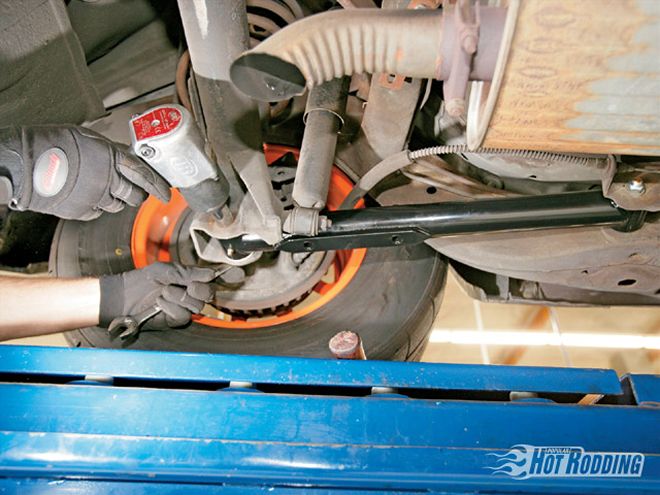
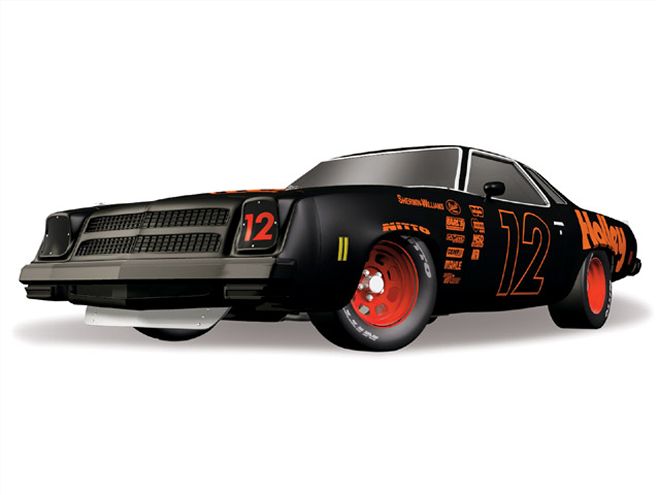
The '73-77 GM rear suspension in our '75 Chevy Laguna project car is similar to its predecessor from the '64-72 A-body. Both use a triangulated four-link geometry; four bars that locate the rear axle laterally, longitudinally, and that provide for a range of vertical motion that is optimal for pinion angle. The key to understanding a triangulated four link is to understanding that each bar--along with the joint at each end of each bar--serves multiple functions. In order to keep the rearend planted in a proper orientation during driving maneuvers, the bars undergo forces of compression, stretching, and their joint ends--rubber bushings--see a good bit of twisting too.
GM used the four-link rear suspension all throughout the muscle car era on its midsized intermediates like the Chevelle, Tempest/LeMans, Cutlass F-85, and Skylark. In fact, all of the rear suspension pieces for these intermediates are interchangeable from 1964 to 1972. For 1973, GM redesigned its intermediates, this time employing computer design for the first time ever. The result was a suspension with a high level of comfort and exceptional geometry; they called it Radial Tuned Suspension, or RTS for short.
The RTS in our '75 Chevy Laguna project car may look a lot like the four-link in the earlier '64-72 A-body, but due to the updated design, none of the rear suspension pieces interchange with the earlier cars. In fact, none of the gazillion aftermarket suspension parts for the '64-72 A-body will swap with the '73-77 A-body (although technically, an adjustable upper rear control arm would work due to its variable length). If you happen to own one of the 7.4 million A-bodies GM made during this time, you have four choices: 1) tough it out with the stock parts and just replace the bushings, 2) doing the same thing, and adding an adjustable upper control arm, 3) gutting the entire stock suspension and going all custom-fabricated, like a race car, or 4) retain the excellent stock suspension geometry and upgrade all the parts with Global West pieces.
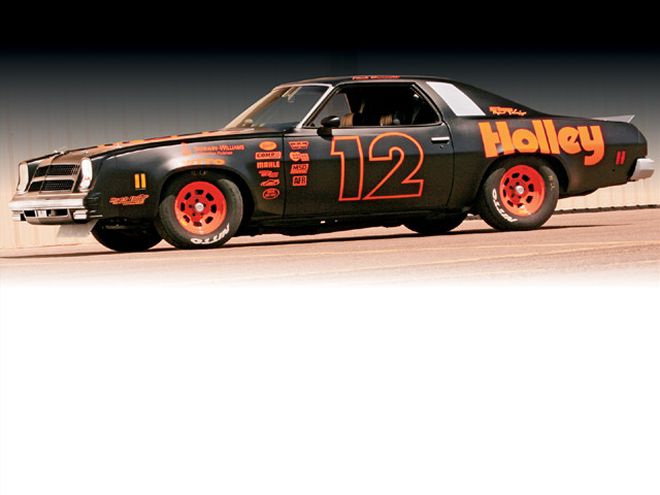
This last choice gives us a suspension with maximum utility on the street, and on the racetrack, and it's perfect for the enthusiast with minimal fabrication chops. As we hope to prove at a later date with some track testing, the Global West setup should offer the Laguna over 90 percent of the handling of a custom-fabricated suspension for a fraction of the cost. It's also a breeze to install in a few hours.
The Global West doctrine for designing suspension parts is pretty rigorous, which is fortunate for late A-body fans, since it's their only choice. For one thing, Global West likes to test everything in a race environment, something that proprietor, Doug Norrdin, has been doing for decades. The San Bernardino, California-based company has a well-burnished reputation for no-nonsense suspensions fitting Camaros (all years), GM A-bodies (all years), Mustangs (early and late Fox platform), Tri-Five Chevys, full-size GMs ('58-70), Mopar B-bodies, and Novas (all years).
The excellent geometry of the stock RTS suspension notwithstanding, the actual infrastructure of these 2-ton-plus coupes leaves a bit to be desired. One of the problems inherent in a triangulated four-link is that the even most minimal deflection in any of the joints--rubber donut bushings in the case of our Laguna--allows a relatively large excursion in axle motion. These lateral axle movements detract from the four link's otherwise flat and predictable handling. Moreover, the deflection of these rubber bushings creates an additional problem with roll bind, whereby the vertical motion of the links is impeded by friction in a non-linear fashion. From a driver's perspective, the sum of these traits feels like mild understeer at the beginning of a turn, changing to increased understeer mid-turn, and then transitioning to lots of snap oversteer as the car's mass finally overcomes the binding in the bushings and the axle deflects laterally.
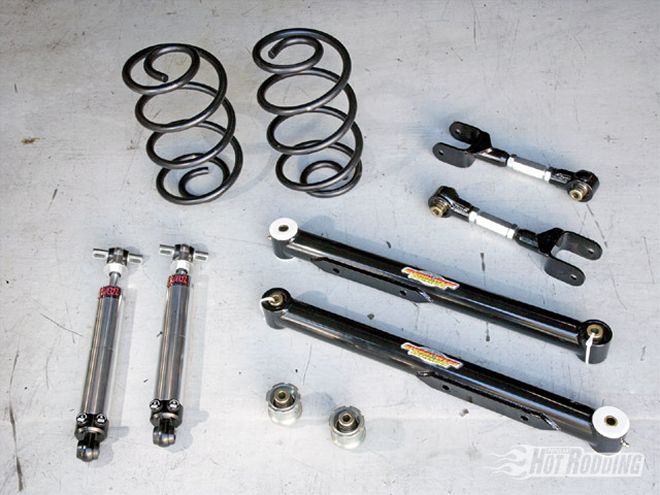 Global West is the only manufacturer we could find that makes a complete rear suspension system for our '75 Laguna project (a '73-77 GM A-body), and we searched for months before making our decision. That suited us fine, as Global West only makes top-shelf stuff. The Global West rear four-link system consists of adjustable upper control arms, lower control arms, rearend bearing inserts, QA1 double-adjustable shocks, and lowering springs. The tally was about $1,700 for everything.
Global West is the only manufacturer we could find that makes a complete rear suspension system for our '75 Laguna project (a '73-77 GM A-body), and we searched for months before making our decision. That suited us fine, as Global West only makes top-shelf stuff. The Global West rear four-link system consists of adjustable upper control arms, lower control arms, rearend bearing inserts, QA1 double-adjustable shocks, and lowering springs. The tally was about $1,700 for everything.
The way Global West attacks this problem is two-fold. First, they use strong materials for the arms in order to better resist deflection. A CNC-machined 0.250-inch-thick wall mild-steel billet is used for the upper rear arms, and a 0.125-inch-thick DOM mild-steel tubing is used for the lowers. These are powdercoated to resist corrosion. Secondly, all eight articulated joints (two for each link) are designed for zero deflection, while allowing friction-free movement.
The upper double-adjustable arms (part No. TBC-37) use a high-misalignment spherical bearing on the chassis end, and a polyurethane bushing on the axle side. We do, however, recommend upgrading to the spherical bearing kit (SP-47) for the axle side, which makes it a solid link from the axle to the chassis. The spherical bearing kit allows the control arm to twist without binding under heavy body roll--the big plus being that it requires no modification to your axle housing, which for us is an 8.5-inch 10-bolt that we plan on keeping. The Global West uppers are also double-adjustable with a hexagonal section threaded for both left- and right-handed threads. This allows the user to adjust pinion angle without disconnecting the arms (to change their length).
 The lower control arms install very easily; it's just a matter of unbolting the stock arm, and swapping in the new one. Eric Norrdin of Global West performed our install, and he suggests that if the bolt holes don't line up, lift the frame a bit to rotate the axle housing.
The lower control arms install very easily; it's just a matter of unbolting the stock arm, and swapping in the new one. Eric Norrdin of Global West performed our install, and he suggests that if the bolt holes don't line up, lift the frame a bit to rotate the axle housing.
The joints for Global West's lower control arm set (part No. TBC-13) also use a high-misalignment spherical bearing on the chassis end, but a Del-a-lum bushing on the axle side. The Del-a-lum bushing is a sandwich of durable Delrin and aluminum. Delrin offers a low-friction surface that's quiet and wear resistant, yet has very high resistance to deformation, making it ideal for this sort of thing.
So the bones of our Laguna's rear suspension consists of Global West's TBC-37 upper control arms with the SP-47 bearing kit, and the TBC-13 lower control arms. But maintaining the proper geometry is only half the battle. None of these things matter in the least if you can't transfer the load from the tire to the ground. Springs and dampers (shock absorbers) are responsible for that. In a heavy car like the Laguna, the right springs and shocks can make a huge difference.
The actions of a spring and a damper are intimately intertwined. A spring stores road energy--heavy springs store and release this energy more quickly, and light springs do it more slowly. On the racetrack, it helps to store and release the energy quickly, so the tire can stay in contact with the road, and act on the car. The only downside is that a spring oscillates, and that oscillation needs to be controlled by a damper. As a rule, a stiffer spring needs a stronger, more viscous damper to control oscillation. By extension, lighter springs need less dampening to control them. So springs and shock absorbers need to be conceptualized as a matched pair, whereby the spring is optimized for the road and the car's intended use, and the shock damper is subsequently designed to control the spring oscillation.
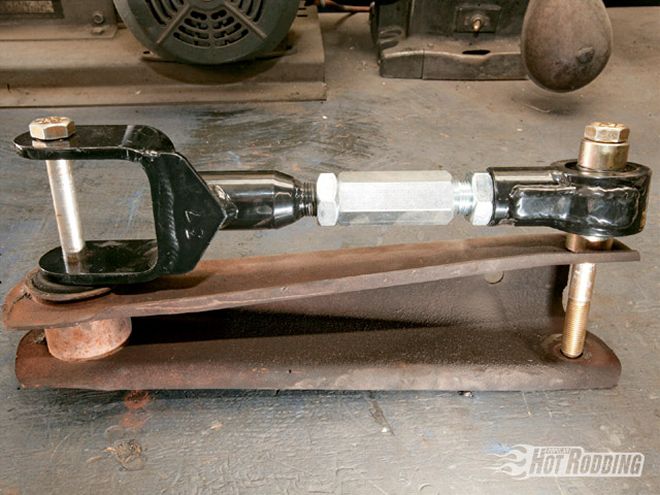 The new Global West upper control arms will have to be adjusted for length before being installed. The old ones can be used as a template by using guide bolts. Note the hex-sided center section, for easy fine-tuning on the car. The jamb nuts keep everything locked, but should be loosened for adjusting the length.
The new Global West upper control arms will have to be adjusted for length before being installed. The old ones can be used as a template by using guide bolts. Note the hex-sided center section, for easy fine-tuning on the car. The jamb nuts keep everything locked, but should be loosened for adjusting the length.
Springs are rated in pounds per linear inch of deflection. In the case of our stock Laguna spring, it takes about 125 pounds of force to compress the spring 1 inch. We substituted this for a Global West spring (part No. S-61) with a rate of 160 lb/in, which should allow the tires to follow the road contour at high speed much better. The stock shock absorber, however, cannot completely control the higher spring rate, and the oscillation that goes with it, so we brought another expert into our loop: QA1 Motorsports.
We decided that to get the most out of our improved suspension, we needed a double-adjustable shock, meaning that the amount of damping force can be set independently for both compression (when the tire is shoved up into the fender by a bump), and rebound (when the spring extends the tire downward, as with a pothole or dip). QA1's Stocker Star double-adjustable shock was the answer. If you have a Laguna or any '73-77 GM A-body, the proper double-adjustable Stocker Star shock for the rear is a part No. DTC-1661P, which has the proper range of travel for a near-stock ride height, or slightly lower. We discovered that due to our dropped ride height (we lost track when it got to be more than 2 inches) a shorter shock was required, so we substituted part No. DTC-1915P. Had we used the longer shock, we would've damaged it internally, rendering it useless. (Since Global West is a QA1 distributor, you should consult with their staff about your ride height so they can recommend the proper QA1 shock.)
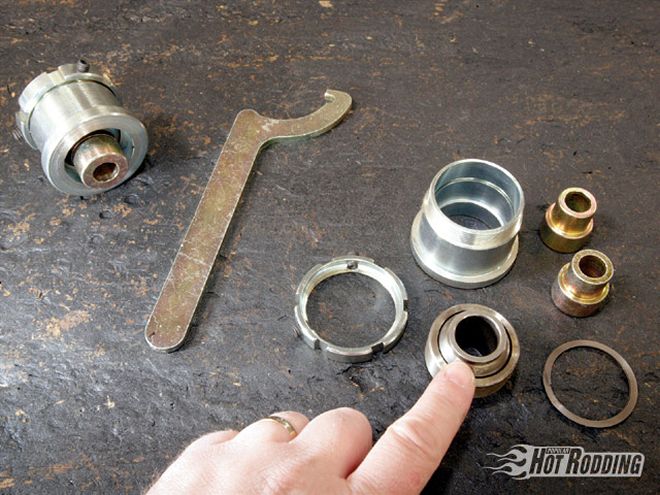 The rearend bearing kit is what makes the Global West system work so well. It eliminates any deflection or play in the upper control arm by way of a chromoly, high-misaligment spherical bearing. These are fitted inside the rearend housing in place of more customary rubber bushings.
The rearend bearing kit is what makes the Global West system work so well. It eliminates any deflection or play in the upper control arm by way of a chromoly, high-misaligment spherical bearing. These are fitted inside the rearend housing in place of more customary rubber bushings.
Before we get on with the installation, one word about antisway bars. Our Laguna did have a rear bar from the factory, which we opted to remove. I've found that with a sufficiently stiff suspension all around, the rear sway bar becomes less crucial, and can even hurt handling. A rear sway bar in conjunction with a stiff rear suspension can cause oversteer, although intuitively you wouldn't think so. The reason is that a modest amount of rear body roll can actually help plant the outside tire earlier in the corner, and improve bite. A stock-type sway bar like ours is mounted to the control arms, with most of its mass being unsprung weight, so if we do elect to put one back on at a later date, it will be mounted to the chassis, and connected to the axle with end links.
Of course, no rear suspension can operate properly without a matching front suspension, and we haven't forgotten about that. The day following our rear suspension installation at Global West, we came back to do the front half. The difference is like night and day. We were concerned that it might be too stiff, but when we hit the road, we found it quite compliant, only much more sporting. Probably more than any other thing, we noticed that the car felt significantly lighter, even though we know otherwise. Where it would wallow and porpoise over bumps and dips, it's now tight and taught. All we lack is some time on a road course to tweak our QA1 shocks. Next month, we'll take the wraps off our Global West front suspension!
WHERE THE MONEY WENT DESCRIPTION: Part No.: Price: Lower rear control arms TBC-13 $397.14 Upper adjustable rear control arms TBC-37 $310.75 Rearend bearing inserts for upper control arms SP-47 $290.27 QA1 double-adjustable shocks DTC-1915P* $559.95 Rear lowering springs S-61 $141.25 Total: $1,699.36 *needs eyelet kit